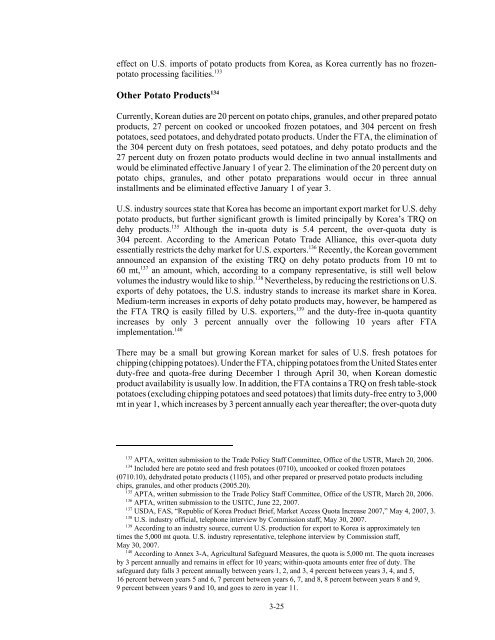U.S.-Korea Free Trade Agreement: Potential Economy-wide ... - USITC
U.S.-Korea Free Trade Agreement: Potential Economy-wide ... - USITC
U.S.-Korea Free Trade Agreement: Potential Economy-wide ... - USITC
Create successful ePaper yourself
Turn your PDF publications into a flip-book with our unique Google optimized e-Paper software.
effect on U.S. imports of potato products from <strong>Korea</strong>, as <strong>Korea</strong> currently has no frozenpotato<br />
processing facilities. 133<br />
Other Potato Products 134<br />
Currently, <strong>Korea</strong>n duties are 20 percent on potato chips, granules, and other prepared potato<br />
products, 27 percent on cooked or uncooked frozen potatoes, and 304 percent on fresh<br />
potatoes, seed potatoes, and dehydrated potato products. Under the FTA, the elimination of<br />
the 304 percent duty on fresh potatoes, seed potatoes, and dehy potato products and the<br />
27 percent duty on frozen potato products would decline in two annual installments and<br />
would be eliminated effective January 1 of year 2. The elimination of the 20 percent duty on<br />
potato chips, granules, and other potato preparations would occur in three annual<br />
installments and be eliminated effective January 1 of year 3.<br />
U.S. industry sources state that <strong>Korea</strong> has become an important export market for U.S. dehy<br />
potato products, but further significant growth is limited principally by <strong>Korea</strong>’s TRQ on<br />
dehy products. 135 Although the in-quota duty is 5.4 percent, the over-quota duty is<br />
304 percent. According to the American Potato <strong>Trade</strong> Alliance, this over-quota duty<br />
essentially restricts the dehy market for U.S. exporters. 136 Recently, the <strong>Korea</strong>n government<br />
announced an expansion of the existing TRQ on dehy potato products from 10 mt to<br />
60 mt, 137 an amount, which, according to a company representative, is still well below<br />
volumes the industry would like to ship. 138 Nevertheless, by reducing the restrictions on U.S.<br />
exports of dehy potatoes, the U.S. industry stands to increase its market share in <strong>Korea</strong>.<br />
Medium-term increases in exports of dehy potato products may, however, be hampered as<br />
the FTA TRQ is easily filled by U.S. exporters, 139 and the duty-free in-quota quantity<br />
increases by only 3 percent annually over the following 10 years after FTA<br />
implementation. 140<br />
There may be a small but growing <strong>Korea</strong>n market for sales of U.S. fresh potatoes for<br />
chipping (chipping potatoes). Under the FTA, chipping potatoes from the United States enter<br />
duty-free and quota-free during December 1 through April 30, when <strong>Korea</strong>n domestic<br />
product availability is usually low. In addition, the FTA contains a TRQ on fresh table-stock<br />
potatoes (excluding chipping potatoes and seed potatoes) that limits duty-free entry to 3,000<br />
mt in year 1, which increases by 3 percent annually each year thereafter; the over-quota duty<br />
133 APTA, written submission to the <strong>Trade</strong> Policy Staff Committee, Office of the USTR, March 20, 2006.<br />
134 Included here are potato seed and fresh potatoes (0710), uncooked or cooked frozen potatoes<br />
(0710.10), dehydrated potato products (1105), and other prepared or preserved potato products including<br />
chips, granules, and other products (2005.20).<br />
135 APTA, written submission to the <strong>Trade</strong> Policy Staff Committee, Office of the USTR, March 20, 2006.<br />
136 APTA, written submission to the <strong>USITC</strong>, June 22, 2007.<br />
137 USDA, FAS, “Republic of <strong>Korea</strong> Product Brief, Market Access Quota Increase 2007,” May 4, 2007, 3.<br />
138 U.S. industry official, telephone interview by Commission staff, May 30, 2007.<br />
139 According to an industry source, current U.S. production for export to <strong>Korea</strong> is approximately ten<br />
times the 5,000 mt quota. U.S. industry representative, telephone interview by Commission staff,<br />
May 30, 2007.<br />
140 According to Annex 3-A, Agricultural Safeguard Measures, the quota is 5,000 mt. The quota increases<br />
by 3 percent annually and remains in effect for 10 years; within-quota amounts enter free of duty. The<br />
safeguard duty falls 3 percent annually between years 1, 2, and 3, 4 percent between years 3, 4, and 5,<br />
16 percent between years 5 and 6, 7 percent between years 6, 7, and 8, 8 percent between years 8 and 9,<br />
9 percent between years 9 and 10, and goes to zero in year 11.<br />
3-25

















